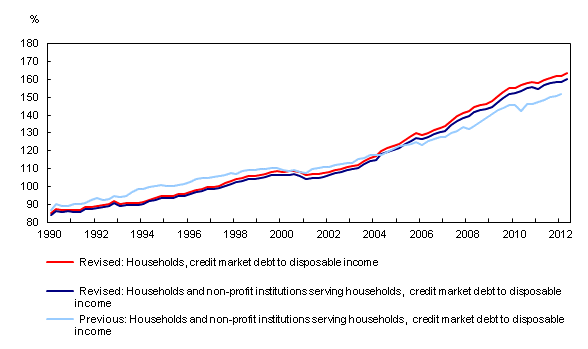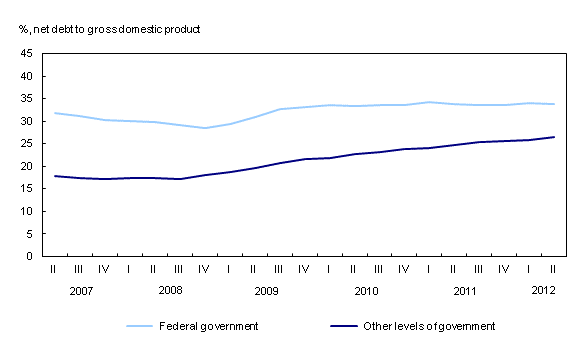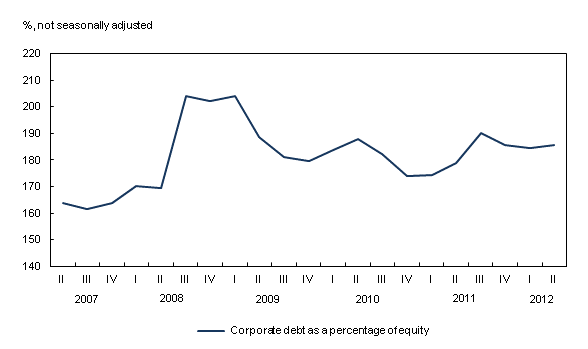National balance sheet accounts, second quarter 2012
Archived Content
Information identified as archived is provided for reference, research or recordkeeping purposes. It is not subject to the Government of Canada Web Standards and has not been altered or updated since it was archived. Please "contact us" to request a format other than those available.
Related subjects
-
[an error occurred while processing this directive]
The implementation of revised international System of National Accounts economic accounting standards resulted in a downward revision to Canada's national net worth. Both household debt and net worth were revised upward. In the second quarter of 2012, national net worth increased by 1.2% to $6.8 trillion, up from $6.7 trillion in the first quarter.
Revisions to national net worth
The historical revision of the national balance sheet accounts introduced five significant changes to the nation's measure of non-financial assets and thus national wealth. These include the capitalization of research and development activities; the capitalization of military weapons systems; an improved valuation of the corporate sector's non-financial assets; an improved valuation of the government sector's non-financial assets; and the use of new source data in valuing the residential net stock.
On October 1, 2012, Canada's net foreign debt was historically revised. This revision also had an impact on Canada's national net worth. For 2011, national net worth was revised downward by $64 billion. On a per capita basis, national net worth was revised from $190,200 to $188,300.
Revisions to classifications, valuation and methodology
In the previous vintage of the national balance sheet accounts, the household sector included the activities of non-profit institutions serving households. In this new presentation, the activities of non-profit institutions serving households have been moved to a new sector.
An updated classification of financial assets and liabilities has been implemented with the historical revision of the national balance sheet accounts. The classification more closely reflects the classification proposed by the international System of National Accounts (SNA 2008) standard. One of the major advantages of the revised data is that it provides a much clearer picture of the value of equity by sector.
Prior to the historical revision, all types of equity were grouped together. The historically revised data separate equity into listed shares, unlisted shares, mutual fund shares, government claim equity and foreign investment equity. Furthermore, all corporate sector equity is now recorded at market value, whereas prior to the historical revision, only listed shares and mutual fund shares were recorded at market value.
A revised methodology was adopted in the compilation of estimates of financial assets and financial liabilities in the national balance sheet accounts. This resulted in a relatively large revision to certain categories of financial assets and financial liabilities including mortgages, mutual funds, cash and deposits and life insurance and pensions. In addition to the revision resulting from the change in methodology, additional revisions were a result of new and improved data sources.
Revisions to the household sector
The revision to the classifications as well as improved valuation and methodology had an impact on a number of key household sector financial indicators.
For 2011, household net worth was revised upward from $6.3 trillion to $6.6 trillion. The majority of this increase was due to improved valuation of unlisted shares. Unlisted shares are now recorded at market value rather than book value. This added approximately $108 billion to household net worth. On a per capita basis, household net worth was revised from $182,900 to $190,800.
The household credit market debt to disposable income ratio was revised upward from 150.6% to 161.7%. This revision is due to three factors. First, the methodological changes in the compilation of the national balance sheet resulted in an upward revision to household credit market debt from $1.59 trillion to $1.61 trillion. Second, there was a redefinition of household disposable income as part of the historical revision of the national gross domestic product (GDP) by income and by expenditure accounts published on October 1, 2012, that lowered this measure. Third, the removal of the non-profit institutions serving households from the household sector served to push the ratio higher since these institutions had a dampening effect on previous estimates.
Impact of revisions in credit market debt to household disposable income

Chart description: Impact of revisions in credit market debt to household disposable income
Revisions to government debt
The historical revision resulted in changes in the level of government net debt. Total government net debt (expressed at book value) was $863 billion in 2011, prior to the historical revision it was estimated at $810 billion. Recent revisions reflect the incorporation of the latest public accounts information while revisions to earlier periods are a result of the incorporation of revised data originating from the historically revised national income and expenditure accounts released on October 1, 2012.
The historical revision to the national GDP in the income and expenditure accounts resulted in a slight upward revision in the level of GDP. The upward revision in GDP was not enough to offset the revision to government net debt — resulting in an overall upward revision in the government net debt to GDP ratio. For 2011, the ratio of total government net debt to GDP was 49.0%, while prior to the historical revision the ratio was 47.1%.
Revisions to corporate leverage
The historical revision increased the value of the private non-financial corporate sector's credit market debt as well as it's equity (both expressed at book value). Credit market debt increased from $845.6 billion to $912.5 billion, while the value of their equity increased from $1.56 trillion to $1.69 trillion. As a result, the credit market debt to equity ratio was revised from 54.1% to 53.9%.
Revisions to financial institutions' equity
The historical revision resulted in a substantial change in the value of mutual fund assets and liabilities recorded in the national balance sheet accounts. New source data and improved coverage of exchange traded funds and fund-of-funds resulted in an upward revision in mutual fund assets from $761 billion to $990 billion for 2011.
Estimates of life insurance were also revised over the period of the historical revision, mainly as a result of the revaluation of corporate claim equity from book value to market value.
Second quarter of 2012
In the second quarter of 2012, national net worth increased by $77 billion or 1.2% to $6.8 trillion, up from $6.7 trillion in the first quarter. On a per capita basis, national net worth expanded from $192,500 in the first quarter to $194,100 in the second quarter.
National net worth changes reflected a 1.4% increase in the value of non-financial assets, moderated by a 10.7% increase in net foreign debt.
Household sector
Household net worth increased by 0.9% in the second quarter of 2012, primarily resulting from a 2.2% rise in the value of residential real estate. However, the value of household net financial assets declined in the second quarter, mainly because of a 5% decline in the value of listed shares.
Growth in household credit market debt continued in the second quarter, increasing 1.8% from the previous quarter, mainly attributable to increases in consumer credit and mortgages. The household credit market debt to disposable income ratio was 163.4%, up from 161.8% in the previous quarter.
Government net debt trends upwards
Total government net debt (expressed at book value) rose to $897 billion, an increase of $20 billion from the first quarter. Expressed as a percentage of GDP, the ratio was 50.1%, up from 49.4% in the previous quarter.
Government net debt to gross domestic product

Chart description: Government net debt to gross domestic product
Corporate leverage
The ratio of total private non-financial corporation credit market debt to equity (expressed at book value) edged up from 55.3% in the first quarter to 55.6% in the second quarter.
Corporate debt-to-equity ratio

Chart description: Corporate debt-to-equity ratio
The value of financial institutions' equity portfolio decreases
In the second quarter of 2012, the value of total financial assets of lending institutions and institutional investors (such as trusteed pension plans and mutual funds) decreased 0.6% to $8.9 trillion from $9.0 trillion in the previous quarter, as a result of a decline in the value of shares as the Toronto Stock Exchange fell 6.4% during the quarter.
Note to readers
The National Balance Sheet Accounts comprise the balance sheets of all sectors of the economy: households, non-profit institutions serving households, financial corporate, non-financial corporate, government, and non-resident sectors. They cover all national non-financial assets and financial claims and their associated liabilities outstanding in all sectors.
National net worth is national wealth less net foreign liabilities (that is, what is owed to non-residents less what non-residents owe to Canadians). Alternatively, it is the sum of the net worth of the household, non-profit institutions serving households, financial corporate, non-financial corporate, and government sectors.
Household credit market debt comprises consumer credit, mortgage, and loan debt of households — which include unincorporated businesses.
Corporate equity is treated as a liability on the balance sheet of the corporate sector since it represents a claim by shareholders on the corporate sector. As a result, as equity prices increase, corporate net worth will tend to decline, reflecting the increase in the corporate sector's equity liabilities.
Definitions concerning financial indicators can be found in Financial indicators from the National Balance Sheet Accounts.
For a more detailed description of the 2012 Historical Revision, consult Revisions analysis - National Balance Sheet Account 2012.
For more information, contact the information officer (csna-info-scnc@statcan.gc.ca).
Available without charge in CANSIM: tables CANSIM table378-0121 to 378-0125.
Definitions, data sources and methods: survey number survey number1806.
The National economic accounts module, accessible from the Key resource module of our website, features an up-to-date portrait of national and provincial economies and their structure.
For more information refer to the Latest Developments in the Canadian Economic Accounts (Catalogue number13-605-X, free). This publication is now available from the Key resource module of our website under Publications.
Data for the third quarter will be released on December 14.
For more information, or to enquire about the concepts, methods or data quality of this release, contact Statistics Canada's National Contact Centre (toll-free 1-800-263-1136; 613-951-8116; infostats@statcan.gc.ca) or Media Relations (613-951-4636; statcan.mediahotline-ligneinfomedias.statcan@canada.ca).
- Date modified:
